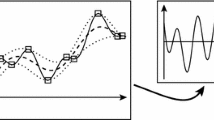The problem of increasing the precision with which the pitch frequency of speech signals is measured is considered. Existing algorithms for determining this frequency are presented and a new algorithm based on complementary ensemble empirical mode decomposition is developed. The results of the investigations confirm the robustness of the algorithm in the presence of frequency modulation of the pitch of speech signals.



Similar content being viewed by others
References
V. G. Mikhailov and L.V. Zlatousova, Measurement of the Parameters of Speech, Radio i Syyaz, Moscow (1987).
A. Camacho and J. G. Harris, “A sawtooth waveform inspired pitch estimator for speech and music,” J. Acoust. Soc. Amer., 123, No. 4, No. 9, 1638–1652 (2008).
E. G. Zhilyakov and A. A. Firsova, “Estimation of the period of the pitch of the sounds of human speech,” Nauch. Vedom. Belgor. Gos. Univ., Ser. Istor. Politol. Ekon. Informat., No. 1 (144), Iss. 25/1, 173–181 (2013).
E. Azarov, M. Vashkevich, and A. Petrovsky, “Instantaneous pitch estimation based on RAPT framework,” in: Proc. 20th Europ. Signal Proc. Conf., EUSIPCO (2012), pp. 2787–2791.
T. Abe, T. Kobayashi, and S. Imai, “Robust pitch estimation with harmonics enhancement in noisy environment based on instantaneous frequency,” in: Proc. ICSLP96 (1996), Vol. 2, pp. 1277–1290.
M. K. Hasan, C. Shahnaz, and S. A. Fattah, “Determination of pitch of noisy speech using dominant harmonic frequency,” in: Proc. IEEE Int. Symp. Circuits and Systems (2003), Vol. 2, pp. 556–559.
A. Chevigne and H. Kawahara, “YIN, a fundamental frequency estimator for speech and music,” J. Acoust. Soc. Amer., 111, No. 4, 1917–1930 (2002).
J. R. Yeh, J. S. Shieh, and N. E. Huang, “Complementary ensemble empirical mode decomposition: A novel noise enhanced data analysis method,” Adv. Adapt. Data Analysis, 2, No. 2, 135–156 (2010).
A. K. Alimuradov and F. Sh. Murtazov, “Methods of increasing the efficiency of recognition of speech signals in voice control systems,” Izmer. Tekhn., No. 10, 20–24 (2015).
A. K. Alimuradov and P. P. Churakov, “Noise-robust speech signals processing for the voice control system based on the complementary ensemble empirical mode decomposition,” in: Int. Sib. Conf. Control and Communications, SIBCON 2015, Omsk, Russia, May 21–23, 2015.
N. E. Huang, S. Zheng, and R. L. Steven, “The empirical mode decomposition and the Hilbert spectrum for nonlinear and nonstationary time series analysis,” Proc. Roy. Soc. London. A, 454, 903–995 (1998).
W. Zhaohua and N. E. Huang, “Ensemble empirical mode decomposition: A noise-assisted data analysis method,” Adv. Adapt. Data Analysis, 1, No. 1, 1–41 (2009).
Sh. Bhawna and K. Sukhvinder, “Distnction between EMD & EEMD algorithm for pitch detection in speech processing,” Int. J. Eng. Trends and Technol., 7, No. 3, 119–125 (2014).
G. Schlotthauer, M. E. Torres, and H. L. Rufi ner, “A new algorithm for instantaneous f0 speech extraction based on ensemble empirical mode decomposition,” in: 17th Europ. Signal Proc. Conf., EUSIPCO 2009, Glasgow, Scotland (2009), pp. 2347–2351.
G. Priyanka and P. Mahendra Kumar, “Determine the pitch markers in speech signal using ensemble empirical mode decomposition,” Int. J. Adv. Res. Comp. Sci. and Software Eng., 2, No. 7, 90–96 (2012).
A. K. Alimuradov, “Investigation of frequency-selective properties of methods of decomposition into empirical modes for the purpose of estimating the pitch frequency of speech signals,” Tr. MFTI, 7, No. 3, 56–68 (2015).
X. Huang, A. Acero, and H.-W. Hon, Spoken Language Processing. Guide to Algorithms and System Development, Prentice-Hall, Upper Saddle River (2001).
Author information
Authors and Affiliations
Corresponding author
Additional information
Translated from Izmeritel’naya Tekhnika, No. 12, pp. 53–57, December, 2016.
Rights and permissions
About this article
Cite this article
Alimuradov, A.K. An Algorithm for Measurement of the Pitch Frequency of Speech Signals Based on Complementary Ensemble Decomposition Into Empirical Modes. Meas Tech 59, 1316–1323 (2017). https://doi.org/10.1007/s11018-017-1135-1
Received:
Published:
Issue Date:
DOI: https://doi.org/10.1007/s11018-017-1135-1




